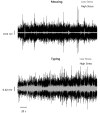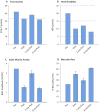Stress management as an adjunct to physical therapy for chronic neck pain
- PMID: 22700538
- PMCID: PMC3461134
- DOI: 10.2522/ptj.20110489
Stress management as an adjunct to physical therapy for chronic neck pain
Abstract
Background and purpose: Chronic neck pain is prevalent in the workplace. Research suggests that psychosocial stress may contribute to the development of neck pain by causing excessive or prolonged muscle activity in some individuals. The purpose of this case report is to describe the rationale, development, and implementation of stress management as an adjunct to standard physical therapist management of chronic neck pain in a female office worker who responded to psychosocial stress with elevated muscle activity prior to treatment.
Case description: A 44-year-old female office employee with an 8-year history of chronic neck pain participated in this case report. The patient was selected from a group of research participants who demonstrated elevated electromyographic (EMG) activity of the trapezius muscle in response to simulated occupational stressors. The multidisciplinary intervention consisted of 8 physical therapy sessions, supplemented by 8 stress management sessions that included EMG biofeedback and psychotherapy to facilitate muscle relaxation.
Outcomes: Neck disability decreased by 50%, trait anxiety decreased by 21%, and the duration of trapezius muscle rest in the workplace increased by 56% immediately after the 8-week intervention. These improvements were maintained 6 months after treatment, and the patient reported a complete absence of neck disability at the 2-year follow-up assessment.
Discussion: A sustained reduction in neck disability was observed for a patient with chronic neck pain after participating in a multidisciplinary intervention that combined physical therapy and stress management approaches to facilitate muscle relaxation in the workplace. Future clinical trials are needed to assess whether stress management is a useful adjunct therapy for patients with chronic neck pain who show elevated muscle activity in response to psychosocial stress.
Figures




Similar articles
-
Relative Effectiveness of Electroacupuncture and Biofeedback in the Treatment of Neck and Upper Back Myofascial Pain: A Randomized Clinical Trial.Arch Phys Med Rehabil. 2020 May;101(5):770-780. doi: 10.1016/j.apmr.2019.12.009. Epub 2020 Jan 16. Arch Phys Med Rehabil. 2020. PMID: 31954696 Clinical Trial.
-
Altered muscle activity during rest and during mental or physical activity is not a trait symptom of migraine - a neck muscle EMG study.J Headache Pain. 2018 Mar 20;19(1):26. doi: 10.1186/s10194-018-0851-5. J Headache Pain. 2018. PMID: 29556874 Free PMC article.
-
Effectiveness of an 8-week exercise programme on pain and specificity of neck muscle activity in patients with chronic neck pain: a randomized controlled study.Eur J Pain. 2013 Nov;17(10):1517-28. doi: 10.1002/j.1532-2149.2013.00321.x. Epub 2013 May 6. Eur J Pain. 2013. PMID: 23649799 Clinical Trial.
-
EMG biofeedback treatment of torticollis: a controlled outcome study.Biofeedback Self Regul. 1991 Dec;16(4):413-48. doi: 10.1007/BF00999994. Biofeedback Self Regul. 1991. PMID: 1760462 Clinical Trial.
-
Effects of biofeedback and strength training interventions on neck-shoulder sensory-motor responses among visual display unit users. A narrative review.J Electromyogr Kinesiol. 2024 Dec;79:102936. doi: 10.1016/j.jelekin.2024.102936. Epub 2024 Sep 20. J Electromyogr Kinesiol. 2024. PMID: 39321540 Review.
Cited by
-
Effectiveness of pulsed electromagnetic field therapy on pain, functional status, and quality of life in patients with chronic non-specific neck pain: A prospective, randomized-controlled study.Turk J Phys Med Rehabil. 2020 May 18;66(2):140-146. doi: 10.5606/tftrd.2020.5169. eCollection 2020 Jun. Turk J Phys Med Rehabil. 2020. PMID: 32760890 Free PMC article.
-
Psychological Interventions for the Management of Chronic Pain: a Review of Current Evidence.Curr Pain Headache Rep. 2015 Sep;19(9):43. doi: 10.1007/s11916-015-0517-9. Curr Pain Headache Rep. 2015. PMID: 26209170 Review.
-
Electroacupuncture at Jing-jiaji points for neck pain caused by cervical spondylosis: a study protocol for a randomized controlled pilot trial.Trials. 2013 Oct 29;14:360. doi: 10.1186/1745-6215-14-360. Trials. 2013. PMID: 24168460 Free PMC article. Clinical Trial.
-
Feasibility study of a LED light irradiation device for the treatment of chronic neck with shoulder muscle pain/stiffness.PLoS One. 2022 Oct 17;17(10):e0276320. doi: 10.1371/journal.pone.0276320. eCollection 2022. PLoS One. 2022. PMID: 36251669 Free PMC article.
-
Psychological therapies for the management of chronic pain.Psychol Res Behav Manag. 2014 Apr 10;7:115-24. doi: 10.2147/PRBM.S44762. eCollection 2014. Psychol Res Behav Manag. 2014. PMID: 24748826 Free PMC article. Review.
References
-
- De Loose V, Burnotte F, Cagnie B, et al. Prevalence and risk factors of neck pain in military office workers. Mil Med. 2008;173:474–479 - PubMed
-
- Guzman J, Hurwitz EL, Carroll LJ, et al. ; for the Bone and Joint Decade 2000–2010 Task Force on Neck Pain and Its Associated Disorders. A new conceptual model of neck pain: linking onset, course, and care. Spine. 2008;33 (suppl 4): S14–S23 - PubMed
-
- Cote P, van der Velde G, Cassidy JD, et al. The burden and determinants of neck pain in workers: results of the Bone and Joint Decade 2000–2010 Task Force on Neck Pain and Its Associated Disorders. Spine. 2008;33 (suppl 4): S60–S74 - PubMed
-
- Bongers PM, Ijmker S, van den Heuvel S, Blatter BM. Epidemiology of work related neck and upper limb problems: psychosocial and personal risk factors (part I) and effective interventions from a bio behavioural perspective (part II). J Occup Rehabil. 2006;16:279–302 - PubMed
Publication types
MeSH terms
Grants and funding
LinkOut - more resources
Full Text Sources
Medical

